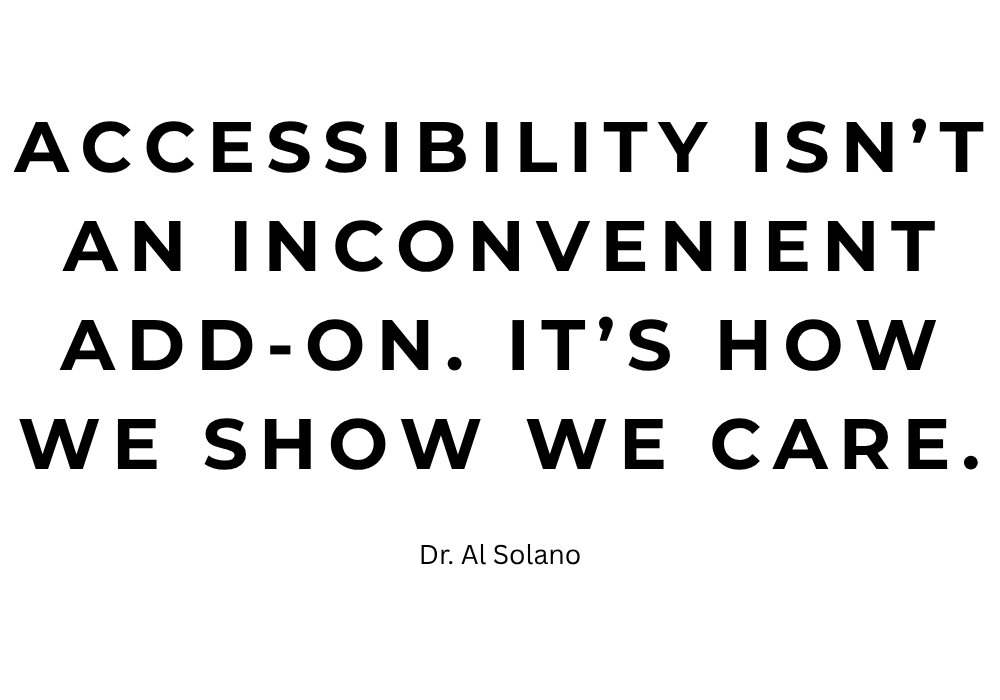Accessibility in Action | 028 | Beyond Compliance, Toward Care
Access as an everyday practice, not an afterthought.
Sometimes one sharp insight is all we need to hold on, reset, or reengage with purpose.
Practical takeaways pulled from the Student Success Podcast, so you don’t have to listen to the whole episode (unless you want to).
Episode with Dr. Denise Maduli-Williams: Show Notes | Apple | Spotify
Dr. Denise Maduli-Williams is English & ELAC Faculty & Accessibility Mentor at San Diego Miramar College. She brings a heart-centered approach to her work and is deeply committed to equity, joy, and practical action that makes classrooms more inclusive and welcoming.
Learn effective accessibility practices she implements at her campus.
1. Start with Alt Text
Alt text provides descriptions for images, enabling screen readers to communicate visual information to students with visual impairments.
· Effective Practice: Write clear, concise descriptions that focus on the image’s purpose.
· Pro Tip: Add alt text to all visuals, including course materials, social media posts, and presentations.
· Action Step: Review your course materials and add alt text to at least one resource this week.
2. Use Captions for All Videos
Captions benefit everyone, not just students with hearing impairments.
· Technology Tools: Use auto-captioning tools like Canvas Studio or YouTube, then edit for accuracy.
· Action Step: Commit to captioning all videos you create or share with your students.
3. Ensure Color Contrast and Avoid Color Dependence
Colorblindness affects many learners; avoid relying on color alone.
· Improve Contrast: Use high-contrast color combinations like dark text on a light background.
· Pro Tip: Don’t use color alone to indicate importance. Add bold text or icons for clarity.
· Action Step: Run your slides or documents through a free color contrast checker to ensure readability.
4. Write Meaningful Links
Avoid generic phrases like ‘Click here.’ Use descriptive language.
· Example: ‘Visit the College Library website’ instead of ‘Click here’.
· Why It Matters: Screen readers rely on link text to provide context.
· Action Step: Update links in your course materials to include descriptive text.
5. Incorporate Universal Design for Learning (UDL)
UDL benefits all students by providing multiple ways to learn and demonstrate understanding.
· Engage Students: Use audio, video, and text resources.
· Assess Flexibly: Offer essays, presentations, or creative projects.
· Action Step: Redesign one assignment to include multiple ways for students to demonstrate mastery.
6. Embrace Accessibility as a Shared Responsibility
Accessibility is everyone’s job, not just for disability support services.
· Faculty Role: Build accessibility in from the start.
· Campus Impact: Accessible communications benefit the whole community.
· Action Step: Choose one accessibility practice to implement this semester.
Equity is a continuous journey, not a checklist. Dr. Maduli-Williams shows us what it looks like to walk the path with kindness.
Let’s connect on LinkedIn.
Onward…
Dr. Al Solano
Founder, Continuous Learning Institute | About
Host, Student Success Podcast
A meaningful test of success is how helpful we are in contributing to our fellow human being’s happiness.



